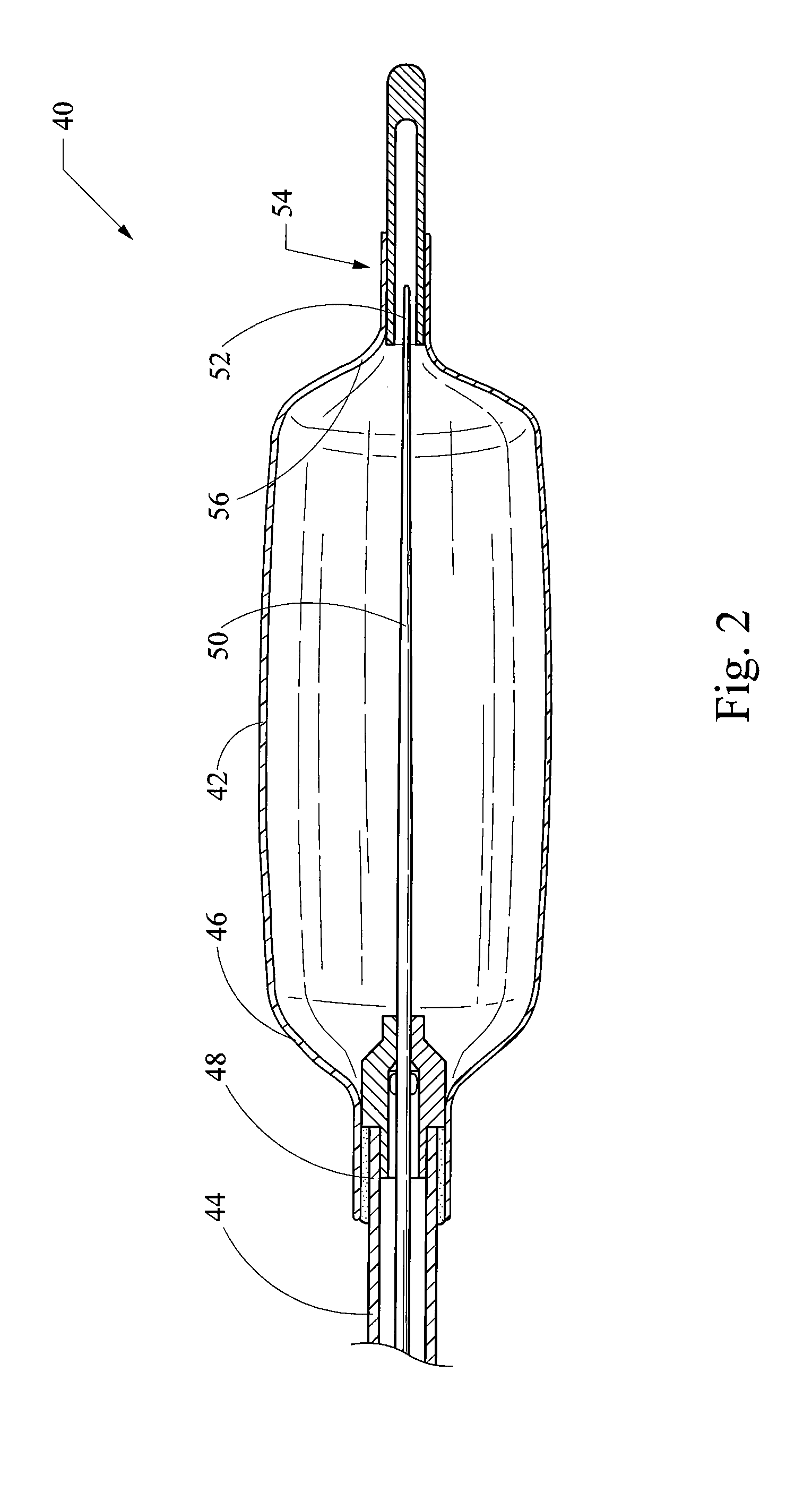Balloon folding control mechanism
a control mechanism and balloon technology, applied in the field of medical devices, can solve the problems of reducing the effectiveness of angioplasty procedures, reducing the cross-sectional area of the balloon, and pdt procedures that do not allow the expansion balloon b>12/b> to exert excess pressure, so as to reduce the cross-sectional area and eliminate the transverse creasing of the central portion of the balloon
- Summary
- Abstract
- Description
- Claims
- Application Information
AI Technical Summary
Benefits of technology
Problems solved by technology
Method used
Image
Examples
first embodiment
[0062]a balloon catheter 100 of the present invention is depicted in FIG. 19, which illustrates the distal portion (i.e., the balloon portion) of the balloon catheter 100. The balloon catheter 100 includes a balloon 102 having a cylindrical central element 104 and a pair of conical end elements 106. The balloon 102 is typically manufactured from a non-elastomeric material (e.g., a semi-rigid or non-compliant material), and preferably comprises a translucent, transparent or optically clear film. For example, the balloon 102 could be manufactured from a biocompatible polymer such as polyamide, polyurethane, polyester, polyolefin, polyethylene terephthalate and the like. The balloon 102 is generally manufactured as a unitary structure and in the shape of its 3-dimensional inflated stated.
[0063]The proximal end of the balloon 102 is fixedly connected to the distal end of a flexible elongate outer catheter 108. The proximal end of the outer catheter 108 includes a hub (not shown) that is...
second embodiment
[0071]FIG. 20 is a cross-sectional side view of the distal portion of the slip joint balloon catheter 100 of FIG. 19. However, this figure illustrates a balloon folding control mechanism 130 in accordance with the present invention. In this particular embodiment, the balloon folding control mechanism 130 comprises a stop collar 142 affixed to the stiffening member 116 at a specific distance X from the proximal face of the end cap 120. As explained above in connection with FIG. 19, the distance X represents the maximum amount of shortening that the balloon 102 will be allowed to undergo during deflation, and is selected based upon the aspect ratio of the balloon and the folding mode desired. For example, with respect to the balloon catheter 100 illustrated in FIGS. 19 and 20, the balloon 102 has an aspect ratio of about 1.8. With reference to FIG. 18, and assuming that a 3-wing folding configuration is desired, a slight amount of shortening is required such that the ratio S / D would b...
third embodiment
[0072]FIG. 21 is a cross-sectional side view of the distal portion of the slip joint balloon catheter 100 of FIG. 19. However, this figure illustrates a balloon folding control mechanism 130 in accordance with the present invention. In this particular embodiment, the balloon folding control mechanism 130 comprises a stop collar 152 in combination with a compression spring 154. The stop collar 152 is affixed to the stiffening member 116 and engages the proximal end of the spring 154. The spring 154 is positioned between the stop collar 152 and the proximal face of the end cap 120, and is configured to apply a biasing force therebetween. The position of the stop collar 152 and / or the length of the spring 154 may be selected to ensure that the spring 154 engages the end cap 120, or engages the end cap 120 at a specified force level, thereby inhibiting excessive shortening of the balloon 102. Because the spring 154 may be pre-loaded in compression, it is capable of lengthening and thus ...
PUM
 Login to View More
Login to View More Abstract
Description
Claims
Application Information
 Login to View More
Login to View More - R&D
- Intellectual Property
- Life Sciences
- Materials
- Tech Scout
- Unparalleled Data Quality
- Higher Quality Content
- 60% Fewer Hallucinations
Browse by: Latest US Patents, China's latest patents, Technical Efficacy Thesaurus, Application Domain, Technology Topic, Popular Technical Reports.
© 2025 PatSnap. All rights reserved.Legal|Privacy policy|Modern Slavery Act Transparency Statement|Sitemap|About US| Contact US: help@patsnap.com



